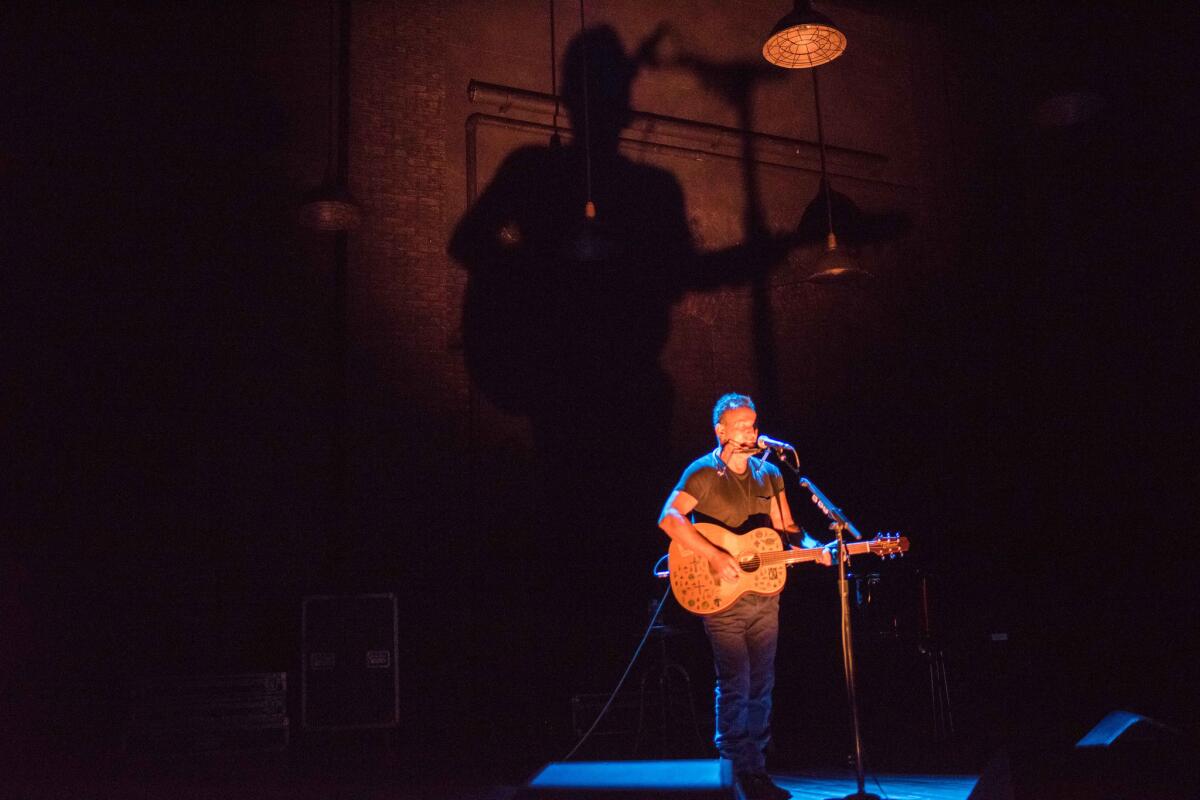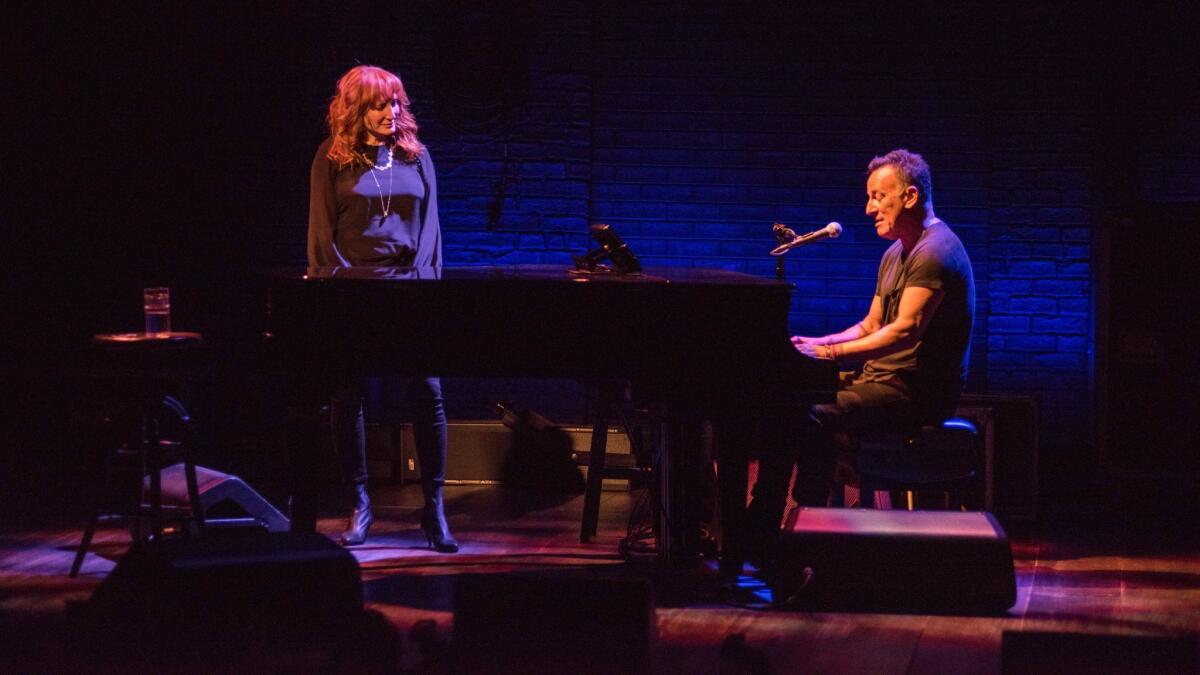Review: ‘Springsteen on Broadway’: A rock-star confessional with heart
The question hanging over Bruce Springsteen’s Broadway debut was whether the show was going to be a concert relocated to accommodate a rock star’s aging vocal cords and fan base, or a genuine theatrical offering somewhere between a trumped-up cabaret and a stripped-down musical.
Having now experienced “Springsteen on Broadway” at the Walter Kerr Theatre, where the show is making “Hamilton” suddenly seem like a box-office slowpoke with its runaway ticket prices, I am still not sure how to categorize this intimate, dreamlike encounter with a music legend accustomed to selling out football stadiums.
A special event if ever there was one, “Springsteen on Broadway,” which had its official opening Thursday, slips out of genres to invent a new hybrid form. Call it a confessional jam session.
ANOTHER TAKE: 'Springsteen on Broadway' puts the Boss in a box
Nomenclature aside, there’s no denying that the man of Broadway’s fall season is delivering a performance that few lucky enough to attend will ever forget. This is Bruce (no last name needed) unplugged, but the show goes far deeper than a hothouse exhibition of an artist unwinding while the MTV cameras roll.
Alone on stage for nearly the entire performance, the 68-year-old rock ’n' roller accompanies himself while looking back in rugged tranquillity. His songs provide the road map for where he’s been. The crags in his still commanding voice mark the distance between now and then, but he brings the guitar-slinging, piano-pounding, harmonica-blowing heat along with the retrospective wisdom.

Elvis Presley, the Beatles and Bob Dylan are touchstones for Springsteen, but I found myself connecting his inner intensity to a certain school of American acting, the one that includes Marlon Brando, Al Pacino,
Kafka said that a book should serve as the axe to break up the frozen sea inside us. Springsteen uses his music to dissect the psychology of its creation. The songs bring him back to the places and people, the longings and the losses, that inspired their birth — the distant father whose approval he could never seem to win as a kid, the devoted mother who held the family together by sheer force of will, the band mates and industry gurus, the women he loved and ran away from.
There’s too much lyrical patter for this to qualify as a concert. Much of the talk is lifted straight from his superb 2016 memoir, “Born to Run,” a book that sets a new literary standard for the celebrity stroll down memory lane. Springsteen is billed as both writer and director of the show, which doles out the writing in lumpy portions in the opening setup built around “Growin’ Up” from his 1973 debut album, “Greetings From Asbury Park, N.J.” But everything quickly snaps into place. The anecdotes Springsteen relates have a shaggy dog quality, but the feelings they summon in him inspire the choice turns of phrase and vivid imagery of his best songs. He traces the Garden State geography of his imagination to once again see Mary’s dress swaying as she walks through the screen door and dances to the lonely sounds of Roy Orbison in “Thunder Road.”
Springsteen could easily have turned his autobiography over to Broadway hacks, who would have jumped at the chance at adapting his life story into a jukebox musical. But thankfully he created something more artfully haunting than “Jersey Boy: Asbury Park Edition.”
Springsteen is, of course, portraying himself, but he’s reckoning with his own myth, peeling back layers to rediscover the boy from Freehold, N.J.
His prose, even when overripe, conveys the richness of his heart. But his presence onstage communicates his soul. Springsteen’s stage demeanor exudes a radiant fervor. His eyes seem to preface every thing he says and sings with the words, “Bless me, Father, for I have sinned.” (His sly smile suggests he knows he’ll sin again, but once a Catholic boy, always a Catholic boy.) Toward the end of the two-hour intermission-less show, he intones The Lord’s Prayer, but by then it’s clear that “Springsteen on Broadway” is for him a kind of sacrament.
On a set by Heather Wolensky that throws into relief the beauty of the Walter Kerr stage and encapsulated by the lighting sorcery of Natasha Katz, Springsteen runs slowly through lyrics he knows were lost in the upsurge of pop glory. But he keeps his tendency for marathon overkill in check, taking his time while staying on course. He doesn’t set out to impress yet ends up impressing all the more for his desire to be true — to the songwriting, to the shared moment with his faithful fans and to his own mutable yet continuous self.
Anthem-style rock took his commercial success to a stratospheric level in the 1980s, but here he divulges what was whispering to him in the songs that were cycling regularly on Top 40 radio. Although often presumed to be blindly patriotic, “Born in the U.S.A.” was a protest song about bearing witness to the struggles of veterans and workers politicians would rather ignore. He modestly points this out, but it’s only when he removes the sonic bluster that he reveals the song’s Woody Guthrie heart.
The melancholy underlying “Dancing in the Dark,” Springsteen’s biggest hit, holds sway in a rendition that is almost dirge-like in its quiet beauty. Like so many of us, Springsteen is worried about America’s drift away from its ideals, but he doesn’t get on his soapbox. His political remarks stem from his commitment to everyday people. He’d rather connect than proselytize, recognizing as he says that the secret of his success, “the magic trick,” is the bond he has with those who inspire him to sing in the first place.

SIGN UP for the free Essential Arts & Culture newsletter »
Perhaps the most moving instance of this is when his wife, Patti Scialfa Springsteen, joins him onstage for a pair of numinous numbers, “Tougher Than the Rest” and “Brilliant Disguise.” They barely make eye contact, but the way he glows as she gently shadows his voice, caressing it in a vocal penumbra, tells you everything you need to know about their enduring love.
Springsteen can’t help ironically noting that when he wrote all those car songs he didn’t even have a driver’s license, when he sang about returning soldiers he wondered who died in his place in Vietnam and when he became the bard of factory workers he felt a little self-conscious that he had manage to skate through life without having to hold down a 9 to 5 job. He may be rich and famous and charging a fortune for tickets, but he’s no phony.
By the time the show concludes with “Born to Run,” Springsteen has the audience packed in beside him for a last chance power drive. Broadway, it turns out, is an ideal highway for his mature artistry.
Follow me @charlesmcnulty
The biggest entertainment stories
Get our big stories about Hollywood, film, television, music, arts, culture and more right in your inbox as soon as they publish.
You may occasionally receive promotional content from the Los Angeles Times.








